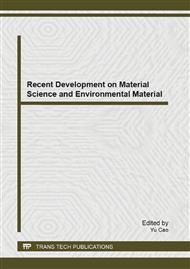p.440
p.447
p.454
p.459
p.464
p.471
p.476
p.483
p.488
Preparation and Photocatalytic Activity of TiO2/Tourmaline Composite Catalyst
Abstract:
TiO2/tourmaline composite photocatalyst was prepared by sol-gel method using tetrabutyl orthotitanate (Ti (OC4H9)4) as a precursor. As a comparison, pure TiO2 was prepared at the same experimental conditons without the addition of tourmaline. The obtained composite photocatalyst was characterized by X-Ray diffraction (XRD) and scanning electron microscope (SEM) and its photocatalytic activity was also investigated through the photodiscoloration of methyl orange (MO) under UV irradiation. The XRD results indicated that, in the composite photocatalyst, TiO2 existed in the form of anatase and rutile, with the sintering temperature and tourmaline content increasing, the anatase phase trended to the transformation to rutile phase. The SEM results revealed that the nanosized particles of TiO2 were well dispersed and immobilized on the surface of tourmaline, especially for the sample with 2% tourmaline content. Compared with pure TiO2, the composite photocatalyst exhibited a higher photocatalytic activity. When the pure TiO2 was used as the photocatalyst, the MO discoloration ratio only reached 55%. However, the MO discoloration ratio could approach 100% in presence of TiO2/tourmaline composit photocatalyst under the same conditions. The effects of tourmaline content and sintering temperature on the photocatalytic activity of the composite were studied in this work and the results suggested that the sample with 2% tourmaline content and sintered at the temperature of 550°C exhibited the best photocatalytic activity. Finally, the possible mechanism for the photodiscoloration of MO was put forward.
Info:
Periodical:
Pages:
464-470
Citation:
Online since:
September 2013
Authors:
Keywords:
Price:
Сopyright:
© 2013 Trans Tech Publications Ltd. All Rights Reserved
Share:
Citation:


